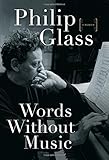 Reviewed by Magdalena Ball
Reviewed by Magdalena Ball
Words Without Music
By Philip Glass
Faber
ISBN:9780571323722, April 2015, 496pages, Hardcover, AUD $49.99
As one of the most influential composers of the 20th century, Philip Glass transformed the landscape of modern music. His work is Renaissance-like in its scope; the breadth of his projects a wide sweep that encompasses Opera, film scores, symphonies, music theatre, concertos, and the list goes on. To call him a musical genius would be easy. What’s not so easy is to track just how much work there is behind the exquisite music he’s given to the world—not some extraordinary inspiration—just hard yakka and lots of it. If something caught Glass’ interest—and almost everything interests him—he would begin a course of study that involved hours and hours of deep, regimented study and practice. There are never any short cuts. Travelling to remote places to spend time with various teachers, beginning a myriad of projects, taking hold of nearly every opportunity that came his way to grow and learn by studying, practicing and drilling are what characterises Glass’ approach to his craft. I opened the book thinking I’d read an autobiography of a great composer. Instead, I found a deeply introspective story of a man whose work has grown out of a desire to understand life from the inside—at the point where the atoms move.
The book begins with Glass’ young years in Baltimore, where he grew up, the son of well-educated Jewish Lithuanian migrants. His mother Ida was an English teacher/librarian and his father Ben owned a record store. Though they didn’t approve of his desire to become a musician, Glass’ parents paid for music lessons, which began early when a young Glass would take the streetcar to Peabody Conservatory to study flute. When he was eleven, he began to work in his father’s store. The book progresses in a reasonably chronological fashion, through his early schooling and the start of a lifelong love of music, his early entry to the University of Chicago where he obtained a degree in Mathematics and Philosophy, his studies at Julliard, with Ravi Shankar, in Paris with Nadia Boulinger on a Fulbright Scholarship, his visits to India and Nepal to study Yoga and Tibetan Buddhism, his time in a very Bohemian New York’s East Village, his work in the theatre with his then wife Joanne Akalaitis, his immersion in the world of Art, the creation of his operas, his film scoring and his time with his second wife Candy Jernigan.
Throughout this period, Glass not only throws himself wholeheartedly into his work, but also into his spirituality, and into earning a good living. He takes on all sorts of ‘day jobs’ and not only does them well, he seems to take great pleasure out of doing them exceptionally well—whether that’s moving furniture, teaching himself plumbing on the job (!), driving a taxi, or helping his dad out in the record store–there’s an attention and interest shown to everything that turns the work into almost an art. In fact, if there’s one theme that can be found throughout the book, it’s this kind of mindfulness—the art of paying complete attention – whether that be fixing a broken sink, working at a composition, or listening to a challenging piece of music:
The mechanics of perception and attention tied you to the flow of the music in a way that was compelling and that made the story irrelevant.
When you get to that level of attention, two things happen: one, the structure (form) and the content become identical; two, the listener experiences and emotional buoyancy. Once we let go of the narrative and allow ourselves to enter the flow of the music, the buoyancy that we experience is both addictive and attractive and attains a high emotional level. (221)
The story itself is compelling and would probably have been so even if the book weren’t so well-written: there are several love stories, lots of famous names and collaborations, travels to interesting places, and a very wide range of influences and references from literature, art, music, dance and theatre. Glass, however, writes beautifully, exploring, always, the deeper and universal implications of his experiences. The prose is beautiful to read—both simple and powerful. Glass’ recounts are more than just memoir. He is generous in that whatever he writes is always aimed at finding a deeper and collective meaning in his individual experiences. There is so much to learn here, not just about Glass, but about ourselves—how to live, how to learn, how to create. Towards the end of the book, Glass talks about his work on The Cocteau Trilogy in which he says, of Cocteau, that he “is teaching about creativity in terms of the power of the artist, which we now understand to be the power of transformation” (378) The same can be said of Words Without Music. Glass fans will love it of course, and there are detailed deconstructions of most of Glass’ big works: from the making of to the meaning of. However, Words Without Music is a book for all readers—the lessons it provides and the journey it takes us on, is both beautifully expressed and universally applicable.